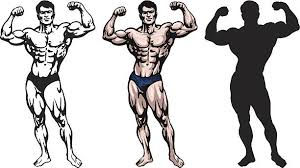How Powerlifting Helps in Natural Muscle Growth
- buildyourmuscle99
- Jun 15
- 3 min read

When most people think of powerlifting, they imagine athletes focused solely on brute strength—not muscle size. But here’s the truth: powerlifting is one of the most effective training styles for building natural muscle growth, especially when combined with smart programming and proper recovery.
In this article, we’ll explore how powerlifting contributes to natural muscle gain, the principles behind its effectiveness, and how you can incorporate it into your own routine—whether you're training for strength, size, or both.
What is Powerlifting?
Powerlifting is a strength sport based on three core lifts:
Squat
Bench Press
Deadlift
The goal is to lift as much weight as possible for one rep in each of these exercises. Unlike bodybuilding, which focuses on aesthetics and muscle definition, powerlifting focuses on maximum strength in key compound movements.
But here’s the connection: these same movements are incredible mass-builders, and they play a major role in developing thick, dense, natural muscle.
Powerlifting and Natural Muscle Growth: The Link
H3: 1. Compound Lifts Recruit Maximum Muscle Fibers
The big three powerlifting movements involve multiple joints and muscle groups. For example:
The squat hits your quads, glutes, hamstrings, and core.
The deadlift engages nearly every posterior chain muscle, including back, glutes, and hamstrings.
The bench press targets chest, shoulders, and triceps.
These compound lifts recruit the largest possible amount of muscle fibers, which leads to stronger stimulus for muscle growth compared to isolated movements alone.
H3: 2. Progressive Overload at Its Core
The foundation of powerlifting is progressive overload—the gradual increase in weight lifted over time. This principle is also the #1 driver of natural muscle growth.
Your body adapts to increasing resistance by getting bigger and stronger. Powerlifters often track every rep and weight lifted, ensuring consistent progress week by week—a strategy any muscle-focused lifter can benefit from.
H3: 3. Improved Neuromuscular Efficiency
Lifting heavy loads improves the efficiency of your nervous system, allowing your muscles to fire more effectively. This translates into stronger muscle contractions, better form, and the ability to lift more weight—which ultimately leads to greater muscle stimulation.
As your central nervous system becomes more efficient, your muscles can be trained harder and recover faster, accelerating natural muscle growth.
H3: 4. Increased Testosterone and Growth Hormone
Heavy resistance training like powerlifting naturally boosts anabolic hormones like testosterone and growth hormone. These hormones are essential for muscle repair, recovery, and hypertrophy.
Multiple studies show that compound lifts performed with high intensity can lead to significant short-term hormonal spikes that support natural muscle growth—especially when paired with proper nutrition and rest.
How to Combine Powerlifting with Hypertrophy Training
While powerlifters don’t always train with the same volume as bodybuilders, combining the two methods is ideal for muscle size and strength.
H3: Powerbuilding — The Best of Both Worlds
“Powerbuilding” blends powerlifting-style strength training with higher-rep bodybuilding work. A sample weekly structure could include:
Day 1: Squat Focus + Accessory Leg Work
Day 2: Bench Focus + Chest/Triceps Hypertrophy Sets
Day 3: Deadlift Focus + Back/Biceps Volume Work
This approach ensures that you’re training for max strength in the big lifts while also getting the volume needed for hypertrophy.
Powerlifting for Beginners: Getting Started
If you're new to powerlifting, here’s how to safely incorporate it into your routine for natural muscle growth:
Master technique with light weights before progressing.
Train 3–4 times per week to allow for recovery.
Track your lifts and aim for small, consistent progress.
Combine heavy lifts with accessory exercises like lunges, rows, and dips.
Prioritize sleep and nutrition, especially protein intake (aim for 1.6–2.2g/kg of bodyweight).
Nutrition for Powerlifting and Muscle Growth
Heavy training increases your need for recovery fuel. Support natural muscle growth with:
A calorie surplus (eat more than you burn)
Adequate protein intake
Plenty of whole foods for micronutrients and recovery
Post-workout nutrition (protein + carbs) to rebuild muscle
Final Thoughts: Powerlifting Is More Than Just Strength
If you're serious about natural muscle growth, don’t overlook the power of powerlifting. The combination of heavy compound movements, progressive overload, and hormonal stimulation makes it one of the most efficient ways to gain size naturally.
Powerlifting builds a solid foundation of muscle—and when combined with proper accessory work and recovery, it can help you grow faster than traditional isolation workouts alone.




Comments